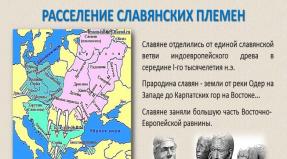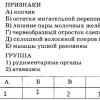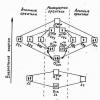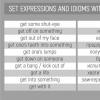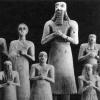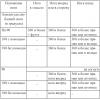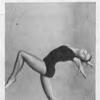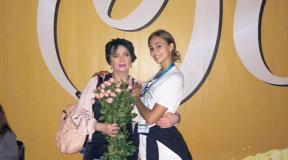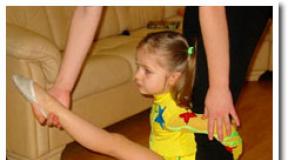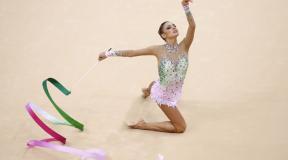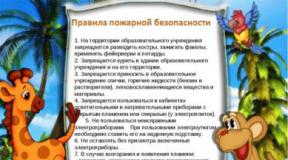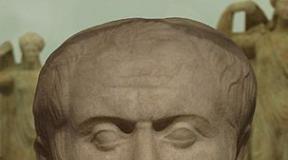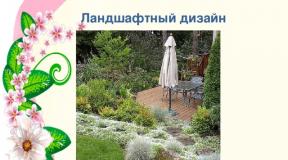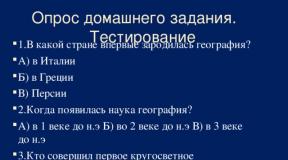Balance of arabesques in rhythmic gymnastics. Classification of movements in rhythmic gymnastics. Basic characteristics for equilibria
Balance refers to such applied physical abilities of our body, the inability to use which makes a person awkward, angular, and fearful. Balance exercises improve the vestibular apparatus, develop skills and abilities to maintain stability in various body positions, movements and unexpected stops. To do this, a person must have a certain strength and be able to make appropriate compensatory movements in order to correctly maintain the center of gravity of the body above the support area. In this case, the body is in a stable position (static equilibrium). With dynamic balance, this position is constantly disrupted and restored by active muscle work. In this case, the correct position of the head and general posture of a person is important, as well as the ability to move smoothly; without sharp jolts, change the relative position of body parts. Gymnasts learn all this by doing balance exercises.
Among the well-known balance exercises in women's gymnastics, various stands on a reduced area of support, sharp stops after movements, movements with a complicated position of the body and simple turns are used.
Balance exercises are usually divided into static and dynamic.
When performing static exercises, it is necessary to evenly distribute the weight over the entire foot, especially all the toes, avoiding relaxation of the muscles of the legs and torso, and correctly distribute muscle efforts. The latter becomes decisive when performing dynamic balance exercises, such as stopping on the toes after walking, running, jumping, etc. Standing on the toes (toes) can be taken technically in two different ways: stepping on the toe (toes) of a straight leg or rising on the toe(s) are springy, i.e. through a half-squat on the entire foot. The same applies to the technique of making turns. Twists are a form of dynamic balance exercise. They can be simple or very complex in technique. The latter are not widely used in women's gymnastics, as they require long learning and a high level of physical qualities. Nevertheless, the balance function is successfully improved by the entire system of exercises in women's gymnastics. This is facilitated by the combinations of walking, running, spring movements, bouncing, jumping and turning that are characteristic of women's gymnastics. In classes they relate to each other and to the dance steps in different ways. Swings, especially swings, as well as turns during jumps, provide a good load for the vestibular apparatus.
Sample exercises
1. Walking along a marked line, on a gymnastic bench, climbing on a gymnastic wall.
2. Fast and deep squats followed by a jump up.
3. Stand on one leg (on the entire foot), the other in various positions. The same, with various movements of the free leg and arms (Fig. 27). The same, in combination with various forms of movement.
4. Stand on your toes, arms in different positions. The same after running, spring movements, squats and jumping. The same, with turns of the torso and head, with tilting and changing the position of the torso (Fig. 28, a b).
5. Stand on the toes of one leg (stepping on the toes and standing across the entire foot), the other leg and arms in various positions. The same, with various movements of the free leg and changes in the position of the torso and arms. The same, take a running start and hold the accepted position (Fig. 29).

6. Vertical balance. Same thing, from a running start. The same, through a half squat on one leg. The same, on the toe, standing across the entire foot and stepping on the toe.
7. Front balance. Same thing, from a running start. The same, from a deep squat. Repeat at pace.
8. Round half squat. Same thing, from a running start. Same thing, from a jump. The same, on one leg, the other in different positions.
9. Springing, transferring weight forward and backward, swing your arms forward and upward to stand on your toes.
The terms are very important in sports and rhythmic gymnastics, as well as in acrobatics and trampoline jumping, since performing the exercises requires precision and mutual understanding between the coach and the athlete. An accurate understanding of special names is positively reflected in the gymnasts' training and final results. In addition to terms denoting movements, equipment and equipment have special names, and there are special rules for the formation of new concepts.
Gymnastics terminology is very interesting for beginning gymnasts. Senior athletes already habitually say difficult-to-understand phrases from short words, shouting “sed”, “mach” in the hall, and their charges meekly translate them into the most complex body movements. Short - because the tricks are done in groups of several pieces, each element lasts a fraction of a second, and here professional speech is adapted to the difficult everyday life of gymnasts. Terms are taught in sports educational institutions, then they are repeated at qualifications and retraining courses.
But young gymnasts find it difficult to understand complex phrases, and they are in no hurry to explain them. But before novice athletes not only learn sports words and learn to translate them into beautiful and graceful movements, they need to take into account several points that will allow them to practice for a long time while maintaining health.

Try to comprehensively study the sport you are involved in, study the theory, safety precautions, and it will be easier for you in difficult moments, which are abundant in this sport. Gymnastics is the most difficult sport, it is an activity for the strongest in body and spirit, but it is precisely this feature that forces you to take into account even the smallest details, which seem to refer to just words - terms.
Terminological requirements
Terms should be easy to understand, so it is advisable that they be built on words of the native language, as well as from borrowed words from another language, but only those that have an international meaning. If you form terms not according to the rules of word formation, as well as from incomprehensible words, then they will not be remembered and will not be perceived by ear.
 Also, the terms must accurately convey the action in the exercise, in this case they will improve the interaction between the coach and the athlete and mastering the exercise itself will be faster. An important property is ease of pronunciation; terminological concepts should be brief and easy to pronounce.
Also, the terms must accurately convey the action in the exercise, in this case they will improve the interaction between the coach and the athlete and mastering the exercise itself will be faster. An important property is ease of pronunciation; terminological concepts should be brief and easy to pronounce.
In gymnastics and related sports, studying terminology is important while observing safety precautions, so special names in this sport have a big difference in pronunciation, which allows you to avoid misunderstandings even with short, not very clear commands.
The terms are divided into:
- general, which are used for general concepts such as floor exercises, strength exercises;
- the main ones, which are also called specific - they determine the signs of movements, such as hanging, half-turning, turning;
- additional - they specify the way in which the exercise should be performed, the direction of movement - for example, an arc, a kip, you can also supplement them with words characterizing the dynamics - quickly, softly, and so on.
General developmental and floor exercises

With a skipping rope
- A jump is a small jump without or with advancement.
- Double jump - two jumps with a spring - the first is strong, the second is smaller in height, varieties - a jump from the right to the left (leg), a loop jump and others.
Exercises on apparatus

In previous materials, we explained what a score consists of and how it is derived, and also introduced readers to the definition of a jump. Today we will talk about the next group of body elements - balances. For advice on the rules, we turned to the 2007 Universiade champion, coach and national category judge, Polina Kondaurova.
We found out that the athlete’s exercise contains from 6 to 9 elements. Of these, at least 2 jumps, 2 balances and 2 turns.
In order for the reader to understand what forms of equilibrium there are, we recommend looking at the table.
Basic characteristics for equilibria:
1. clearly defined and fixed shape (stop position)
2. performed on relevé, on the entire foot (for some types of balances this is allowed, but the value of the element is reduced by 0.1) or on various parts of the body
What are the most common mistakes when performing balances?
- Fuzzy shape. Equilibrium must be established and maintained for a long period of time, sufficient to show the operation of the item.
- If the balance is performed on a relevé, landing on the heel will cancel the value of the element.
Equilibria also include turlyans, Italian fouettés and the former elements of flexibility and waves.
Turlyan - slow turn on the foot, chest, elbows (until recently, turns on the knee were also performed, but due to the risk of injury they were prohibited).
It is allowed to perform 1 turn on the relevé or on the entire foot in the chosen form. The value of a Turlyan is determined by adding 0.10 points to the base value of Equilibrium for 180 degrees or more. That is, if an athlete does a 360-degree front balance turn, its value is calculated as follows: 0.3 (form) +0.1*2 (for every 180 degrees) = 0.5.
It is not allowed to perform turlans on the knee, on the forearms and in the “Cossack” position.
Italian fouette - these are at least three different forms of balance, which are interconnected by a fouetté beat at least 180 degrees. Each form of balance must be fixed and coordinated with the subject. Counts as one element. Example:
There are also separate mixed equilibria . These are two or more balances performed without taking support (without lowering onto the heel). The value is determined by the sum of equilibria + 0.1. We will talk about mixed difficulties in more detail later.
As with all elements of the body, the most important requirement is its connection with the element of the subject. That is, in order for the balance to be counted, work must be done by the object during its execution. If the work is not completed, as well as in the event of loss (or error in work) of the item, the element is not counted. We have already talked about this, but it is worth focusing on the work of the object, even for a partial understanding of the picture on the carpet.
What does it take to be able to stand in balance? First of all, developed muscles, good choreographic preparation and developed vestibular apparatus, stretching, flexibility, the ability to coordinate the work of an object and body statics. Balancing on one leg, as well as turning, requires a strong Achilles tendon.
The center of gravity of a person is located in the lower abdomen, because... the weight of the legs is about half the weight of the body. The stability of the body depends on the position of the center of gravity and the size of the support area: the lower the center of gravity and the larger the support area, the more stable the body. The location of the center of gravity relative to the support points affects the balance of the body. A person does not fall as long as a vertical line from the center of gravity passes through the area limited by his feet. It is worth saying here that, due to physiological reasons, it is easier for athletes with short legs to balance and make turns. Training is of great importance: it is important to correctly raise and lower your leg, even hold your arms, shoulders and head.
There is another problem, which, however, concerns not only equilibria. Many coaches, chasing results, teach children to stretch and bend to one side. Physiologically, right-handers are better at stretching to the right side, and left-handers are better at stretching to the left. That is, when a gymnast balances, say, in a ring, she often “skews” to one side (it’s easier this way). These are the majority of elements, and the athlete does each of them dozens of times a day. This is a direct path to scoliosis and various spinal injuries.
Of course, elements done in this way fall into the “fuzzy form” category and are not counted, but, nevertheless, children often do them. Please note: if your child is involved in gymnastics, make sure that the preparation is supervised by a competent specialist, because there are often cases when coaches, hoping to get a quick result, injure children.
In the next article we will introduce you to the concept of rotation.
In a side split (the torso should be parallel to the floor):


Split with hold, free leg in the ring (position “in the ring” does not change the value of the element):



Front split:
.jpg)


Free leg back using:



Free leg to the side 90 degrees:

Free leg to the side without assistance:

Front split, body parallel to the floor:


In a split, body parallel to the floor:

.jpg)
.jpg)
In the back split:
.jpg)


In the ring without help:

Rhythmic gymnastics is a complex coordination sport, with a huge number of various motor actions performed both by the gymnast’s body and by objects (rope, ball, clubs, ribbon, hoop) that have various physical properties. According to the classification of the technical committee for rhythmic gymnastics, reflected in the “Rules for rhythmic gymnastics” (2009-2012), the main group of movements consists of jumps, balances, turns and flexibility/waves.
Jumping in rhythmic gymnastics they are distinguished depending on the amplitude of movement, the position of the body and arms in flight. Additional terms often define the position of the body in flight: straight jump, bending jump, bending jump, tuck jump, step, lunge, split, ring. The flip jump and side tipping jump are also popular in other types of gymnastics. Some jumps have a special name - this is a hop, skip and jump - a jump up with a push of one, bending the other leg forward and swinging the arms. Jumps in rhythmic gymnastics are divided into push jumps (push-off from a horizontal support) from two legs and from one. Jumps with a push of two legs differ in the technique of execution: straightening, bending the legs back, touching, “stepping” longitudinally and transversely, etc. Push jumps include: jump, open-closed, step, flip, etc. Jumps can be made by taking off from a place or from a run (the purpose of the run is to achieve the optimal speed for performing a jump).
In exercises with an apparatus, jumps are distinguished by a sufficiently long and high flight - such that the athlete has time to perform other complex movements or manipulations with the apparatus during the flight.
Equilibria are divided into static and dynamic. Static equilibria are divided into vertical and horizontal. Vertical balances are performed with a vertical position of the torso, with various positions of the free leg and arms. Horizontal balances are performed with a horizontal position of the torso and are divided into anterior (the torso is tilted forward), posterior (equilibrium, which is characterized by tilting the torso back while simultaneously lifting the free leg to a horizontal or higher position), lateral (equilibrium, which is characterized by the arrangement of balanced links in the frontal plane). Dynamic equilibria are equilibria with changes in the position of the torso and free leg.
Turns are divided into turns on two legs and one. Turns on two legs - by stepping, crossing 180°, 360°, etc.; on one - the same and different names. The turns of the same name are performed on the right leg to the right side, on the left leg to the left. Opposite turns are performed on the right leg to the left, on the left - to the right, with different positions of the free leg, torso, and arms. An increase in the number of revolutions around a certain axis leads to the complication of an element of a particular structural group.
"Waves" and wave-like movements are characterized by sequential flexion and extension of the joints. “Waves” are performed by the gymnast’s arms and torso. This type of movement is a single combination of flexion-extension actions, which are a holistic dynamic movement. They are characterized by continuity, uniformity and smoothness.
“Other groups” include various movements accompanied by various movements of the arms, head and torso (small jumps, rhythmic steps, swaying, rotations, circular movements, etc.) A special place is occupied by the so-called pre-acrobatic elements: rhythmic gymnastics biomechanical exercise
- 1. Somersaults - rotational movements of the body with sequential contact with the support and turning over the head;
- 2. Inversions - rotational movements of the body with complete inversion and intermediate support;
- 3. Wheel flips, characterized by sequential support with each arm and leg;
- 4. Rolls - exercises characterized by rotational movement of the body with sequential contact with a support without turning over the head with various types of supports (on the chest, forearms, hands).
When performing elements, motor acts such as swings and swings are also performed. Swings are performed with arms, legs and torso. Swinging movements of the body are associated with bending forward, to the side, backward and with turns. Swings with arms and legs are performed in the main and intermediate planes, in different directions, in an arc and in a circle, in the same name, in different names, alternately and sequentially). Swings are performed with the arms, torso (forward and to the side) and the whole body (forward, to the side and with a turn). Swings are characterized by a sharp initial movement in one link and continued movement in other parts of the body. (the sequence of movements is the same as with the “wave”).
Exercises with apparatus are the basis of the classification program in rhythmic gymnastics. The movements of objects can be either free (after throws) or associated with the presence of contact with the gymnast’s body or support (skates, rolls, etc.).
In biomechanics, biological systems are considered as material objects, and to analyze their position in space during movement, they are modeled in the form of a material point or a system of material points. Such models make it possible to fully use the knowledge accumulated in the field of theoretical mechanics. Often, a 14-segment branched kinematic chain is used as a model of the human musculoskeletal system, the links of which, according to their geometric characteristics, correspond to large segments of the human body, and the connection points correspond to the position of the main joints. When studying the movements of gymnasts with developed spinal flexibility, such a model is not entirely adequate in describing movements. In addition, the human motor system has its own structural and functional features, which do not contradict the laws of mechanics, but impose significant restrictions on the possibility of formal application of mechanical models. The absence (partial or complete) of anatomical and physiological components in mechanical models of the human body, such as muscles, joints, ligaments, tendons, and failure to take into account the speed-strength properties of muscles, leads to the fact that such mechanical systems only resemble human locomotion in their kinematic structure. Modern computer technologies make it possible to simulate structures of any complexity. And in the scientific support of such sports as rhythmic gymnastics, the construction of a formal model of the body in the form of a multi-link structure with adequate inter-link connections, and perhaps complicated by additional elastic connections, could become the subject of a dissertation research.
In previous materials, we explained what a score consists of and how it is derived, and also introduced readers to the definition of a jump. Today we will talk about the next group of body elements – balances. For advice on the rules, we turned to the 2007 Universiade champion, coach and national category judge, Polina Kondaurova.We found out that the athlete’s exercise contains from 6 to 9 elements. Of these, at least 2 jumps, 2 balances and 2 turns.
In order for the reader to understand what forms of equilibrium there are, we recommend looking at the table.
Basic characteristics for equilibria:
1. clearly defined and fixed shape (stop position)
2. performed on relevé, on the entire foot (for some types of balances this is allowed, but the value of the element is reduced by 0.1) or on various parts of the body
What are the most common mistakes when performing balances?
Fuzzy shape. Equilibrium must be established and maintained for a long period of time, sufficient to show the operation of the item.
If the balance is performed on a relevé, landing on the heel will cancel the value of the element.
Equilibria also include turlyans, Italian fouettés and the former elements of flexibility and waves.
Turlyan– slow turn on the foot, chest, elbows (until recently, turns on the knee were also performed, but due to the risk of injury they were prohibited).
It is allowed to perform 1 turn on the relevé or on the entire foot in the chosen form. The value of a Turlyan is determined by adding 0.10 points to the base value of Equilibrium for 180 degrees or more. That is, if an athlete does a 360-degree front balance turn, its value is calculated as follows: 0.3 (form) +0.1*2 (for every 180 degrees) = 0.5.
It is not allowed to perform turlans on the knee, on the forearms and in the “Cossack” position.
Italian fouette- these are at least three different forms of balance, which are interconnected by a fouetté beat at least 180 degrees. Each form of balance must be fixed and coordinated with the subject. Counts as one element.
There is also a separate mixed equilibria. These are two or more balances performed without taking support (without lowering onto the heel). The value is determined by the sum of equilibria + 0.1. We will talk about mixed difficulties in more detail later.
As with all elements of the body, the most important requirement is its connection with the element of the subject. That is, in order for the balance to be counted, work must be done by the object during its execution. If the work is not completed, as well as in the event of loss (or error in work) of the item, the element is not counted. We have already talked about this, but it is worth focusing on the work of the object, even for a partial understanding of the picture on the carpet.
What does it take to be able to stand in balance? First of all, developed muscles, good choreographic preparation and developed vestibular apparatus, stretching, flexibility, the ability to coordinate the work of an object and body statics. Balancing on one leg, as well as turning, requires a strong Achilles tendon.
The center of gravity of a person is located in the lower abdomen, because... the weight of the legs is about half the weight of the body. The stability of the body depends on the position of the center of gravity and the size of the support area: the lower the center of gravity and the larger the support area, the more stable the body. The location of the center of gravity relative to the support points affects the balance of the body. A person does not fall as long as a vertical line from the center of gravity passes through the area limited by his feet. It is worth saying here that, due to physiological reasons, it is easier for athletes with short legs to balance and make turns. Training is of great importance: it is important to correctly raise and lower your leg, even hold your arms, shoulders and head.
There is another problem, which, however, concerns not only equilibria. Many coaches, chasing results, teach children to stretch and bend to one side. Physiologically, right-handers are better at stretching to the right side, and left-handers are better at stretching to the left. That is, when a gymnast balances, say, in a ring, she often “skews” to one side (it’s easier this way). These are the majority of elements, and the athlete does each of them dozens of times a day. This is a direct path to scoliosis and various spinal injuries.
Of course, elements made in this way fall into the “fuzzy form” category and are not counted, but, nevertheless, children often do them. Please note: if your child is involved in gymnastics, make sure that the preparation is supervised by a competent specialist, because there are often cases when coaches, hoping to get a quick result, injure children.
In the next article we will introduce you to the concept of rotation.


